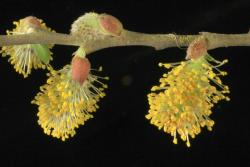Trees or shrubs deciduous; if shrubs then erect, ascending procumbent, or prostrate. Branches terete. Terminal bud usually absent; flower and leaf buds enclosed by a single scale. Leaves alternate, rarely subopposite or opposite; stipules small, free, deciduous or persistent, in some species becoming larger in mid- to late summer; petiole short; leaf blade very narrowly ovate to elliptical, the leaf margins with teeth ending in a hydathode, margins plane or finely revolute. Dioecious (monoecy is confined to hybrids). Flowering proceeding simultaneous with, or rarely following, leaf emergence; catkins upright or spreading, less often pendulous. Catkins terminal on short branches with chlorophyllose leaves that are smaller than mature leaves but of the same form, and sometimes sterile bracts similar to flower bracts (cataphylls). Flowers of female catkins open simultaneously, flowers of male catkins open sequentially from the base to the catkin apex. Flower bracts 1 per flower, entire, persistent or not. Flowers entomophilous or anemophilous, each with 1–2(6) nectaries. Male flower: nectaries 1–4 in New Zealand species, stamens 2–9 in New Zealand species; filaments free or partly to completely connate, usually exceeding bracts; anthers 2-loculed, opening lengthwise. Female flower: nectaries 1–2, ovary 2-loculed, sessile or on a stipe, glabrous or hairy; style with a short undivided section, dividing into 2 style arms, arms unlobed or bilobed. Capsule 2-valved. Seeds green or grey-green, small, without endosperm, with a pappus of fine hairs.
| 1 | Tree with a single trunk (rarely multiple trunks each >1 m diameter); leaf margins flat, leaf hairs present in young leaves but usually not persistent, when present straight and appressed; petiole with glands at flower bracts uniformly green or yellow-green; stamens either 2 or 3–6 per flower; male nectaries 2(4); ovary glabrous | subgenus Salix |
| Shrub usually with multiple stems branching from near the base; leaf margins usually finely recurved, leaf hairs usually present in young leaves and persistent or not, when present woolly and forming a tomentum, or hairs straight and appressed; flower bracts usually black or brown, often grading to crimson towards the base of the bract; stamens 2, filaments 2 or united as a single filament; male nectaries 1(2); ovary hairy or glabrous | subgenus Vetrix |
| Category | Number |
|---|---|
| Exotic: Fully Naturalised | 12 |
| Exotic: Casual | 7 |
| Exotic: Cultivated | 19 |
| Total | 38 |
Base chromosome number x = 19 (Argus 2010), plants diploid, tetraploid, occasionally hexaploid, rarely triploid.




